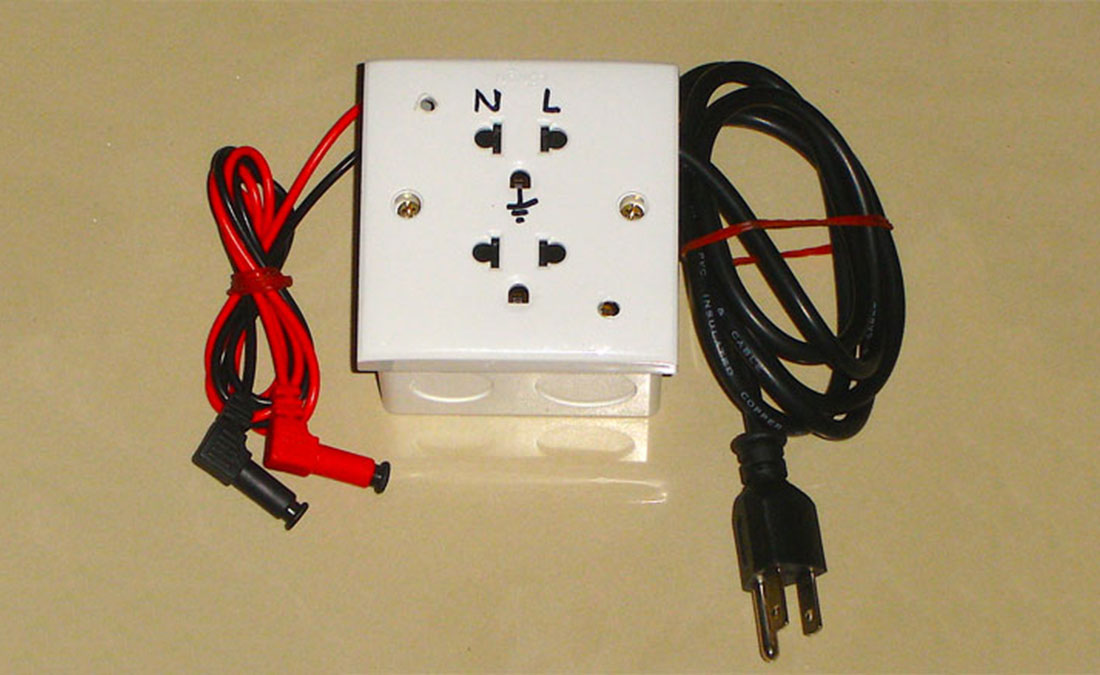Briefly,
• AC True Watts using two quadrant multiplier
• Optimized for 120 VAC (can be changed)
• 15 watt full scale (can be changed)
• Uses DVM floating on AC Neutral as display
• Requires moderately high level of analog circuit skill
• Very inexpensive
Find updates at: www.projects.cappels.org
Introduction
I am doing some work with AC line powered switching circuits and needed a way to measure the true power consumed by the circuit. This little circuit, which seems to have first surfaced in a circuit by Carl Nelson in National Semiconductor application note #222 in 1979, and has been updated by twice in print and once in video Robert Pease at National Semiconductor.
In my implementation, the wattmeter circuitry is contained in an outlet box
and captive leads allow AC voltage input and connection to a digital voltmeter.
The load is plugged into the AC receptacle on the box, leaving an additional
outlet for the voltmeter or a second load. Notice that the banana plugs are the
“safety” types with sheathed contacts so that there is little exposed metal.
The circuit it self is a simple two quadrant multiplier and as such, it only calculates the load power based on one half of the power cycle. This is not a problem for most loads, which draw the same current wave form on both half cycles. For the rare case in which the load draws different current wave forms in the two halves of the power line cycle (assuming single phase power lines) one merely needs to read the power, reverse the plug, read the power, and then average the two readings. I built one, a single range device that measures up to 15 watts with a resolution of 10 milliwatts, using a DVM with 100 microvolt resolution on its 200 millivolt scale. Actually, it can read 20 watts with a slight of linearity. The meter can be modified for other ranges by changing the shunt resistor. A multirange version is described in the references.
REFERENCES
To start with, National Semiconductor Note #222, July 1979
Super Matched Bipolar Transistor Pair Sets New Standards for Drift and Noise
www.national.com/an/AN/AN-222.pdf
Robert Pease’s prelude, how to make a shunt for the wattmeter, What’s All This Shunt Stuff, Anyhow?
http://electronicdesign.com/article/articles/what-s-all-this-shunt-stuff-anyhow-2144.aspx
The Robert Pease article with some circuit improvements, What’s All This Wattmeter Stuff, Anyhow?
http://electronicdesign.com/article/test-and-measurement/what-s-all-this-wattmeter-stuff-anyhow-2190.aspx
Another Robert Pease article, this one making it multi-range, RAP’s Multirange Wattmeter
http://electronicdesign.com/article/test-and-measurement/rap-s-multirange-wattmeter2191.aspx
Youtube video in which Bob Pease explains the circuit and discusses improvements
http://www.youtube.com/watch?v=mkLCs0dBX8E
Same video, different URL
http://video.google.com/videoplay?docid=-8509961694948158452#
Gary Lecomte “Chemelec” in British Colombia, implementation of the wattmeter
including a printed circuit design and a different version of the shunt resistor.
http://www3.telus.net/chemelec/Projects/Watt-Meter/Watt-Meter.htm

